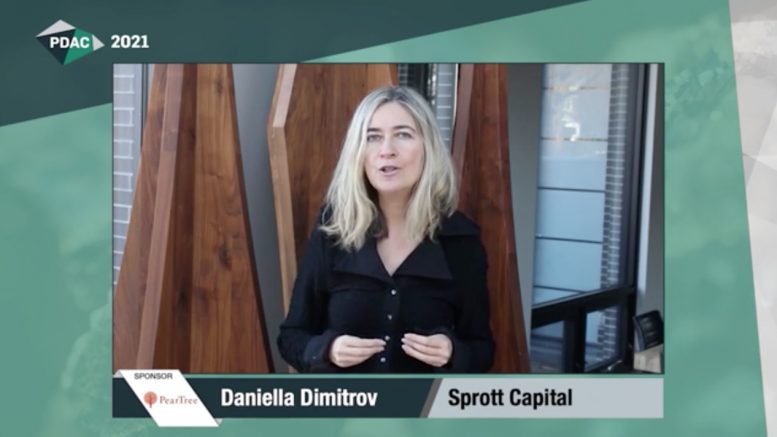Mineral exploration and mining companies that incorporate environmental, social, and governance (ESG) principles as “true value drivers” as part of their corporate culture will outperform and have greater access to more long-term capital and at lower costs, says Sprott Capital’s Daniella Dimitrov.
The principles of ESG are not new to the mining industry, Dimitrov told the virtual audience at this year’s PDAC. “For many years, the industry has been focused on doing the right thing to obtain and maintain our social license to operate.”
While acknowledging the significant benefits that mining has brought to the communities in which they operate, including job creation and maintaining the environment, the S&P Global Ratings, she said, ranks the metals and mining industry at the bottom (along with the oil and gas industry) for its combined environmental and social risks score.
The increased frequency of more catastrophic climate events, the Covid-19 pandemic and its impacts, and the increasing social focus on diversity and inclusion means that ESG has grown and will continue to grow in importance, Dimitrov said. “Not just for stakeholders such as the communities around mining operations but also for governments, regulators, and investors.”
Dimitrov then moved onto the changing stakeholder environment driving ESG in response to the increased demand for ESG disclosure. “Regulators around the world are taking note.”
This month, for example, she noted that European Union regulations on sustainability related disclosures would take effect in the EU and the United Kingdom. These new disclosure requirements aim to enhance transparency around the integration of ESG into investment management decisions and recommendations.
“Many of these requirements will apply to investment managers that do not necessarily have a focus on ESG mandates,” Dimitrov said.
In December 2020, an advisory committee to U.S. Securities and Exchange Commission (SEC) put forward several recommendations, including that the SEC should require the adoption of standards that meet specific criteria by which corporate issuers disclose material ESG risks.
“This disclosure [the committee said] should more closely align to financial disclosure, including aligning [ESG] data with financial metrics as well as making the data and presentation of such information machine-readable in a standard format to ease the compliance review by regulators,” Dimitrov noted.
In July, Ontario’s capital markets modernization task force noted that both issuers and investors had expressed concerns around a standardized framework for ESG disclosure and made several recommendations.
“This means ESG is on the radar of regulators and governments, who could move very quickly to creating regulations around this [ESG] that mirror the comply or report approach that they have taken to governance and diversity,” Dimitrov said.
Investors are increasingly considering ESG factors in their investment decisions, she added. “According to McKinsey [& Company], 25% of all investment funds currently require some form of compliance with ESG criteria.”
Dimitrov also noted that in November, the CEOs of eight of the leading Canadian pension plan investment managers, with assets totalling more than $1.6 trillion, asked that companies measure and disclose their performance on material, industry-relevant ESG factors.
While ESG considerations may not be mainstream for all North American investors, she noted, the number of investors applying ESG reviews as part of their risk assessment and investment decisions is growing and becoming an increasingly important part of the conversation with major investors.
However, a significant challenge for the industry, investors, and stakeholders is the number of different standards, frameworks, and rankings around ESG, Dimitrov said. These include the Global Reporting Initiative, the United Nations Sustainable Development Goals, the World Gold Council’s Responsible Gold Mining Principles, the World Economic Forum’s International Business Council guidelines, and the International Council on Mining and Metals’ Performance Expectations.
“These are just the guidelines, principles, and frameworks,” Dimitrov noted. “There are also ESG rankings, including the MSCI World Index, Bloomberg Sustainability Index, S&P Refinitiv ESG Score, the Institutional Shareholders Services’ ESG rating, and so on. So, I can understand the confusion that is out there on the part of company investors, boards, and shareholders.”
There are also challenges around the capacity and cost for smaller issuers to navigate these frameworks and rankings, she added.
“I hope that a formal framework, universally adopted, will standardize compliance in reporting,” Dimitrov said. “In the meantime, investors believe that the quality and timeliness of ESG could be significantly improved.”


Be the first to comment on "PDAC: Embracing ESG can offer greater access to lower-cost capital, says Sprott’s Daniella Dimitrov"